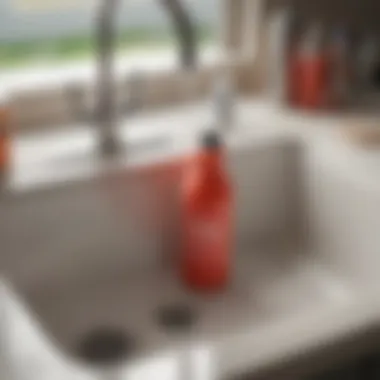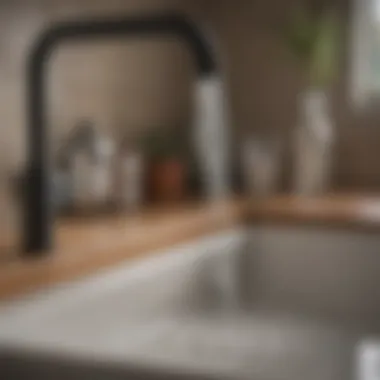Unclogging a Sink: Effective Methods Without a Plunger


Intro
Clogged sinks are a common household problem that can be frustrating and inconvenient. Traditional methods often include using a plunger, but what happens when you find yourself without one? There are numerous alternative techniques for tackling a clogged sink effectively. This article examines various methods, ranging from household items to chemical solutions, and the use of mechanical tools. Each approach is evaluated based on its effectiveness and safety to provide a broader understanding of available options.
Understanding the relevance of dealing with sink clogs is essential for homeowners. This situation frequently arises and knowing how to address it without relying solely on a plunger can save both time and potential stress. The ability to manage this common plumbing issue allows individuals to maintain their home efficiently.
Whether you are a seasoned homeowner or someone new to managing household maintenance, this guide will equip you with practical knowledge to address those irritating sink clogs. Let’s explore these effective methods in detail.
Understanding Sink Clogs
Understanding sink clogs is crucial for any homeowner. A clogged sink can disrupt daily activities, create unpleasant odors, and even lead to more significant plumbing issues. Identifying the nature of a clog allows one to approach the problem more effectively. Without proper understanding, one may resort to ineffective solutions that could worsen the situation.
Moreover, recognizing the types and causes of clogs can help maintain the plumbing system, prolonging the life of pipes and fixtures. Homeowners who grasp this topic can execute preventative measures and respond swiftly when clogs occur, thus minimizing their impact.
Types of Sink Clogs
There are various types of sink clogs that can emerge, each requiring a different approach:
- Partial Clog: This type allows some water to flow. However, it may be slow, suggesting a build-up that needs attention.
- Complete Clog: In this case, water doesn't flow at all, requiring immediate action.
- Intermittent Clog: With this clog, water may drain sometimes but not consistently, indicating an unstable blockage.
Knowing these types helps identify the best method for unclogging, ensuring the most efficient solution is implemented.
Common Causes of Clogs
Clogs can arise from several common sources, including:
- Food Residue: Small particles of food can accumulate in the plumbing, especially in kitchen sinks.
- Grease Build-Up: Oils and fats solidify in pipes, forming sticky walls that trap other debris.
- Hair Accumulation: In bathroom sinks, hair can become entangled with soap scum, leading to blockages.
- Foreign Objects: Sometimes, objects accidentally fall into the sink and create clogs.
Understanding these causes clarifies which preventative actions can be taken to avoid future issues.
Signs of a Clogged Sink
Recognizing the signs of a clogged sink early can prevent greater damage. Common indicators include:
- Slow Drainage: Water takes longer than usual to go down the drain.
- Unpleasant Odors: Foul smells might emanate from the sink, indicating trapped waste.
- Gurgling Noises: Unusual sounds when water is draining can signal air being trapped.
- Backups: Water may come up in the sink or nearby drains, showing there's a serious blockage.
Being aware of these signs assists homeowners in addressing the problem before it escalates, allowing for timely intervention.
Initial Assessment
An initial assessment is critical when dealing with a clogged sink. Before diving into any methods for unclogging, understanding the source and severity of the blockage can significantly affect the effectiveness of the chosen approach. This step serves multiple purposes: identifying the underlying issues, deciding on the appropriate tools or methods to employ, and minimizing the potential for further damage to your plumbing system.
By assessing the clog carefully, one can avoid unnecessary frustration and complications. It provides a focused strategy instead of blindly attempting various solutions that may not work. Spending a few moments on this can save considerable time and effort.
Identifying the Source
Identifying the source of a sink clog involves several observations and checks. Start by evaluating the type of sink. Kitchen sinks often suffer from food debris or grease, while bathroom sinks might be clogged due to hair or soap scum.


Steps to Identify the Source:
- Observe: Check if water drains slowly or not at all. This can indicate a partial or complete clog.
- Inspect: Look for visible debris in and around the drain area. Sometimes, loose hairs or food particles can be removed easily.
- Listen: Pay attention to unusual sounds from your sink. Gurgling or bubbling can suggest trapped air that accompanies a clog.
- Try a Test Sink: If you have multiple sinks, check if they are all clogged. This can help narrow down if the blockage is localized or part of a larger plumbing issue.
After following these steps, you should have a clearer picture of what might be causing the issue. This information will guide you in choosing the right unclogging method.
Evaluating Severity of Clog
Once the source has been identified, evaluating the severity of the clog is the next step. This evaluation plays a significant role in deciding which method to pursue. Different severity levels generally require different approaches.
Considerations for Severity Evaluation:
- Total Blockage: If water does not drain at all, it indicates a complete blockage. A more robust solution will be required.
- Partial Blockage: If water drains slowly, the clog might be movable. This can sometimes be resolved with simpler methods like boiling water.
- Frequency of Clogs: If this is a recurring issue, it may signal deeper plumbing troubles, and one might need to inspect pipes further.
Through this evaluation, you gain insights into the damage's extent and how to tackle the problem wisely.
"Understanding the source and evaluating the severity of a sink clog can significantly enhance the success of your unclogging efforts."
In summary, taking the time for an accurate initial assessment sets the foundation for effectively dealing with a clogged sink, ensuring that homeowners take informed steps based on their specific situation.
Basic Solutions
Basic solutions form the foundation for tackling sink clogs. When other methods are unavailable, these approaches often provide immediate relief. Using household items is both economical and practical. Therefore, exploring this section allows homeowners to act quickly and with minimal effort.
Boiling Water Method
One of the simplest methods to clear minor blockages is the boiling water method. This approach is effective for clogs caused by grease, soap, or food residues. By heating water to a rolling boil, you can easily break down these materials.
To use this method, follow these steps:
- Heat water in a kettle or large pot until it reaches a boil.
- Carefully pour the boiling water directly into the clogged sink in stages, allowing time for it to work through the blockage.
- Observe whether water drains effectively after each pour.
Ensure that your plumbing is safe for this method since older pipes can suffer from thermal shock. Avoid using boiling water on sinks that feature PVC piping. This method, while simple, is often very effective.
Vinegar and Baking Soda
This combination is well-known for its cleaning properties. Using vinegar and baking soda is a natural alternative to harsh chemical cleaners. When combined, they create a chemical reaction that helps to dislodge blockages.
To apply this method:
- Begin by pouring about half a cup of baking soda down the drain.
- Follow it with half a cup of vinegar. A fizzing reaction will occur.
- Allow the mixture to sit for about thirty minutes, preferably longer.
- Rinse with boiling water afterward to clear out any loosened debris.
This method is safe, eco-friendly, and can be repeated as needed, making it a worthwhile solution for ongoing maintenance.
Soap and Hot Water
Soap and hot water offer another viable solution. Specifically, dish soap works best for grease-based clogs. This method lubricates the drain and helps greasy clogs slide through more easily.
To implement this approach:


- Add a generous amount of dish soap into the clogged sink.
- Heat water to just below boiling.
- Pour the hot water over the soap in the sink, allowing it to penetrate the clog.
- Wait and observe if the water begins to drain.
Using soap in this manner not only helps to dissolve the grease, but can also clear away other types of debris. It is a straightforward solution that requires minimal supplies.
Remember, regular maintenance and prompt action when minor clogs occur can prevent larger issues down the road.
Chemical Solutions
Chemical solutions provide a practical approach to tackling stubborn sink clogs, especially when other methods lack effectiveness. Knowing the various types of drain cleaners and their uses can aid homeowners in addressing plumbing issues efficiently. While these products can be beneficial, understanding their application and safety is also crucial. This section covers the overview of drain cleaners, safety considerations, and effective application techniques.
Overview of Drain Cleaners
Drain cleaners are substances designed to break down or dissolve blocking materials within plumbing systems. They typically contain strong chemicals, such as sodium hydroxide, sulfuric acid, or enzymes. Chemical cleaners can be segmented into three main categories:
- Caustic Cleaners: Usually alkaline, they work by producing heat to dissolve organic matter.
- Acidic Cleaners: These contain ingredients that can dissolve clogs quickly, but they may damage pipes if misused.
- Enzymatic Cleaners: These are less aggressive and use enzymes to eat away at waste. They are often safer for the environment and pipes and ideal for routine maintenance.
Although effective, these cleaners come with certain warnings that should not be ignored. Understanding how each type works provides a more informed choice when selecting a product for unclogging sinks.
Safety Considerations
Using chemical solutions requires careful attention to safety. Homeowners should always read the product label and follow the manufacturer's instructions. Here are key safety tips to consider:
- Protective Gear: Always wear gloves and goggles to protect your skin and eyes from chemicals.
- Ventilation: Ensure your workspace is well-ventilated to avoid inhaling harmful vapors.
- Mixing Products: Never mix different drain cleaners, especially acidic and caustic types, as this can produce toxic fumes.
- Disposal: Dispose of leftover chemicals as directed on the product label, following local regulations to prevent environmental harm.
It is important to note that while chemical solutions can provide quick relief, their harsh nature may also lead to long-term damage to plumbing systems if misused.
Application Techniques
Proper application of chemical cleaners enhances their effectiveness while reducing potential risks. Here are some application methods:
- Preparation: Remove any standing water in the sink. If deep, use a bucket to limit water overflow.
- Applying the Cleaner: Pour or squeeze the recommended amount of cleaner directly into the drain. Avoid using excessive amounts; more is not always better.
- Waiting Period: Allow the cleaner to sit for the period specified on the label. This lets the chemicals work effectively on the clog.
- Flushing the Drain: After the waiting time, flush the drain with hot water to assist in clearing debris. For most products, this is an important step to ensure complete removal of the chemical and clog.
By following these strategies, using chemical solutions can become a suitable method for resolving clogs. However, consistent reliance on harsh chemicals may not be the ideal long-term solution, hence balancing prevention and active measures is key in plumbing maintenance.
Mechanical Methods
Mechanical methods for unclogging a sink are essential to this guide as they provide tangible and practical solutions to address stubborn clogs. These techniques rely on tools that physically remove the obstruction rather than utilizing chemical reactions or household items. Understanding the importance of mechanical methods can help homeowners navigate through more challenging clogs that other methods might fail to resolve. Effective mechanical solutions often prevent the recurrence of clogs by swiftly removing the buildup.
Using tools like a drain snake or plumbing auger offers distinct advantages. First, these methods often provide immediate results with less risk than using harsh chemical solutions. Second, they are reusable, making them environmentally friendly and cost-effective over time. However, it is crucial to ensure that the right tool is chosen for the specific situation, as using inappropriate tools can cause damage to the plumbing.
Additionally, users should consider familiarity with each tool and the required techniques. Having the right knowledge and a clear understanding will make the unclogging process smoother and safer.
Using a Drain Snake
A drain snake, or auger, is a flexible tool designed to reach deep into pipes to remove clogs. It's particularly effective for clearing hair, grease, and small debris that can accumulate over time. The ease of use and effectiveness make it a popular choice for many homeowners. To use a drain snake, follow these steps:
- Insert the snake into the drain opening. Ensure that the tip is fully inserted before starting.
- Crank the handle on the snake in a clockwise direction. This motion rotates the coil, allowing it to grasp and break apart the clog.
- Push gently while cranking to penetrate deeper into the pipe if necessary. If you encounter resistance, do not force it. Instead, try rotating it until it breaks free.
- Once the obstruction is cleared, remove the snake and run hot water to flush any remaining debris.
Drain snakes can vary in length and diameter, so selecting one that is appropriate for your plumbing situation is important. Additionally, practice caution while using a drain snake to avoid inadvertent damage to your pipes.


Plumbing Auger Techniques
A plumbing auger is somewhat more robust than a basic drain snake and is suitable for tougher clogs. This tool features a spiral metal end that is specifically designed to bore through clogs of more significant resilience, such as tree roots or debris buildup in larger pipes. When using a plumbing auger, bear in mind the following techniques:
- Select the right auger size. Ensure that the diameter of the auger matches the size of your pipes.
- Insert the auger into the drain, similar to the drain snake method, until the tip meets resistance. The key is to push through any material that may be obstructing the pipe.
- Rotate the handle to help the spiral head latch onto the clog. Once you feel it grip, pull back gently to remove the clog.
- Flush with water to ensure that all residues are washed away.
Using a plumbing auger may require a bit more strength compared to using a drain snake. Thus, homeowners should be prepared for the physical exertion involved. However, the plumbing auger can save time and frustration when dealing with serious clogs, making it a worthy investment for households that experience frequent drainage problems.
Note: Always wear gloves when using these tools to maintain hygiene and safety, as you may encounter unsanitary materials during the unclogging process.
Preventive Measures
Preventive measures are critical in maintaining a functional sink and avoiding frequent clogs. By understanding the importance of proactive care, homeowners can ensure their plumbing systems operate smoothly without recurring issues. Regular attention to maintenance can save time, effort, and expenses associated with dealing with severe clogs and repairs.
Good practices in preventive care encompass not only routine cleaning but also awareness of what goes down the drain. Implementing simple steps can drastically reduce the likelihood of a sink blockage. Take note of the following:
- Monitor what you dispose of: Be mindful of food waste, hair, grease, and other substances. Each of these can contribute to buildup in pipes.
- Use drain covers or strainers: Installing these can easily catch debris and prevent larger objects from entering the drain. They are affordable and easy to replace.
- Regularly check for leaks: Leaky pipes can lead to water pooling and subsequent blockages. Catching these issues early will help in reducing maintenance headaches down the road.
By incorporating these tips, homeowners can enjoy peace of mind and improved plumbing health.
Regular Maintenance Tips
To maintain a clear sink, regular maintenance should be routine. Small efforts can yield long-lasting results. Here are key practices to consider:
- Routine hot water flushing: Pouring hot water down the drain on a weekly basis helps dissolve and flush away small buildups before they become significant clogs.
- Monthly vinegar and baking soda treatment: This combination can break down minor residue in pipes. Simply mix half a cup of each, allow it to sit for a few minutes, and then rinse with hot water.
- Cleaning P-trap regularly: The P-trap is located under the sink, catching debris. Periodically unscrewing it for cleaning will keep clogs at bay.
These tasks can easily be incorporated into household cleaning routines, ensuring the sink remains functional.
Avoiding Common Mistakes
Preventing clogs is as much about knowing what to avoid as it is about taking steps to maintain the plumbing system. Many homeowners make repeat mistakes that contribute to ongoing issues with their sinks. Being aware of these missteps can lead to smoother plumbing operation:
- Pouring grease down the sink: This is a common error that often leads to serious clogs. Instead, allow grease to cool and dispose of it in the trash.
- Ignoring small clogs: Sometimes, a minor blockage may not seem urgent. However, neglecting early signs can lead to larger, more expensive problems later.
- Using harsh chemicals excessively: Frequent use of drain cleaners can damage pipes. Limiting their use and relying more on natural alternatives is advisable for long-term health of plumbing.
Awareness of these points can lead to better management of one's plumbing system, ultimately saving time and expense.
End
These methods are not only practical but also help in fostering a sense of self-reliance within homeowners, allowing them to handle plumbing emergencies without professional intervention. Understanding these approaches contributes to greater home maintenance knowledge, which is highly valuable for real estate enthusiasts and interior design aficionados alike. It's essential to grasp that each method has its limitations and may require different approaches based on the specific clog characteristics.
Recap of Effective Methods
- Boiling Water Method: A simple and effective first step, using boiling water can dissolve buildup and free minor clogs.
- Vinegar and Baking Soda: This classic combination generates a fizzy reaction that can break down organic material blocking pipes.
- Soap and Hot Water: Utilizing soap with hot water can lubricate and dissolve grease that often leads to clogs.
- Drain Snake: A flexible tool that can reach deep into pipes to dislodge stubborn blockages.
- Plumbing Auger: More robust than a snake, this tool is effective for serious clogs that resist other methods.
- Drain Cleaners: Chemical solutions should be approached with caution, weighing their effectiveness against potential harm to pipes.
Each method offers distinct advantages and should be chosen based on the severity and nature of the clog. Regular assessment and appropriate intervention can save time and prevent costly plumbing bills down the line.
Encouragement for DIY Solutions
Successfully unclogging a sink without a plunger can be a satisfying personal achievement. DIY solutions allow individuals to save money and acquire valuable skills.
It is beneficial to experiment with the methods outlined in this article to discover what works best for specific situations.
"Empowerment comes from knowledge and action. By understanding these techniques, every homeowner can gain confidence in managing common plumbing challenges."
In closing, proactive maintenance and practical solutions lead to healthier home environments. Regular attention to plumbing systems can help avoid the inconvenience of clogs before they become major issues.







